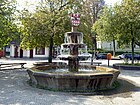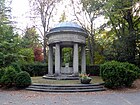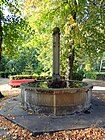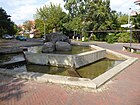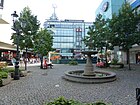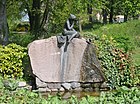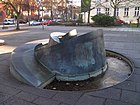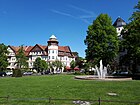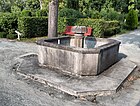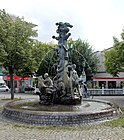List of fountains in the Berlin district of Steglitz-Zehlendorf
The list of wells in the Berlin district of Steglitz-Zehlendorf is a detailed overview of the wells in the public space of the district of Steglitz-Zehlendorf . Wells that are out of service or no longer available are also included, but not simple hand and street pumps .
The list contains 22 objects and is based on the Internet presentation of the Senate Department for Urban Development and Housing about the public fountains in Steglitz-Zehlendorf (15 systems are listed here, as of August 2018), and on other sources. The fountains in the Klein-Glienicke Park and on the Pfaueninsel play a special role in the district , as these were among the first steam-powered irrigation systems in the Berlin-Potsdam garden landscape.
overview
In Steglitz-Zehlendorf, 15 fountains enliven the public spaces and green spaces. According to the Senate, there are a total of 270 functioning ornamental fountains and sea fountains in Berlin, the maintenance of which has been taken over by Berliner Wasserbetriebe since 2017 . Other fountains are open to the public, but they are operated by the Prussian Palaces and Gardens Foundation Berlin-Brandenburg or privately.
List of wells
The sortable compilation is sorted alphabetically by districts and, below that, by streets.
Legend:
- OT: district, where means
- Lankw = Lankwitz , Lifel = Lichterfelde , Nikol = Nikolassee , Stegl = Steglitz , Wanns = Wannsee , Zehld = Zehlendorf
- Name (italic): Name of the well as made by the artist
- Address: nearest street / building and location: geographic coordinates
- Year of construction
- Artist
- Brief description with picture
| OT | Surname | Address and location | year | Artist | Brief description with picture |
|---|---|---|---|---|---|
| Lankw | Large fountain at Bernkastler Platz |
Bernkastler Platz location |
1910 | unknown | The oval clinker basin with a curved seating edge is surrounded by a well-tended green area with pergolas , benches and sculptures. A single jet fountain bubbles in the middle of the pool. |
| Lankw | Four winds fountain | Hanna-Renate-Laurien-Platz location |
1911 | Ludwig Isenbeck with the support of the architect Johannes Hinrichsen and Prof. Tauberl | On the square in front of the north front of the Lankwitz town hall (main entrance) there is an octagonal basin on a three-step pedestal with a round column in the middle, which rests on a square base. It is crowned with a standing female figure (with sickle and basket). Water outlet pipes are attached to the base sides. Four sculptures, mythical creatures that embody the winds, are in front of the corners. The fountain has the inscription on the side: "FOR THE INAUGURATION OF THE TOWN HALL ON SEPTEMBER 2, 1911 DONATED BY NON-BENEFIT CITIZENS". He belongs to the monument ensemble. |
| Lankw | Fountain Seydlitzstrasse 48 | Seydlitzstrasse location |
unknown | The disused fountain is on the corner of Seydlitzstrasse and Dessauerstrasse on private property. Four oblong bowls made of reddish concrete are getting smaller and smaller. | |
| Lifel | Fountain with coat of arms | Ludwig-Beck-Platz location |
1985 | Hartmut Breuer | Three round, stacked bowls are supported by a column in the middle of a twelve-sided basin. At the top are the coats of arms of Steglitz , Lichterfelde and Lankwitz . The water falls over the edges from bowl to bowl into the basin. |
| Lifel | Well temple |
Parkfriedhof Lichterfelde location |
1911 | Friedrich Bauer | At the end of the main path from the Thuner Platz entrance is the temple of the garden with columns (Monopterus) built by the municipal building manager, Freibus. In the middle of the well basin there is a square well with shell-shaped spars on each side. A bronze flower bowl with four curved feet used to stand on the well and a stone putto in front of it. The bronze bowl and gargoyle were stolen, so the fountain is no longer in operation. There is a similarly designed scoop fountain 20 m from the fountain temple. |
| Lifel | Linden fountain | Parkfriedhof Lichterfelde location |
1927 | Erwin Barth | In the middle of a 16-sided fountain basin rests in a separate stone basin with a square floor plan an approx. Two meter high stone column on which a carved cross extends on all four sides and over the entire height. A small bronze cross on a stone ball is the crowning glory. A foot release in the floor outside of the basin can be used for a brief moment to activate four small gargoyles, which are arranged around the base at the foot of the stone column. The water first flows into the smaller, square basin, from where it is drained into the main basin via two thin drainage pipes. This fountain technology was set up in 1999 as part of the renovation of the fountain by means of an inheritance for the Lichterfelde park cemetery. |
| Nikol | Erratic well | At Rohrgarten 89 at the corner of Barkenhof Lage |
1990 | unknown | Four boulders lie in a partly round, partly polygonal natural stone basin, which is surrounded by smaller, stepped basins. Water emerges from the largest boulder, runs off the stone into the central basin and then flows in a cascade from basin to basin. |
| Stegl | Bowl fountain | Franz-Amrehn-Platz location |
1978 | Hartmut Breuer | In the middle of a round basin, a column supports two superimposed bowls with bronze rims. The water exits at the top, falls into the upper bowl, from there into the lower one and then into the basin. |
| Stegl | Hermann-Ehlers-Platz fountain | Hermann-Ehlers-Platz location |
1986 | unknown |
With this pretty fountain system, the unusual shape of the basin is what catches the eye. A semicircular bulge on each of the four sides gives the elongated basin its peculiarity. The particularly wide stepped clinker border can be used as a seat.
A multi-jet central fountain emits delicate, curved water jets into the basin, while at the same time two lower white water fountains, which are arranged in the longitudinal axis, bubble up. |
| Stegl | Fountain in the Steglitz city park |
Stadtpark Steglitz location |
1957 | Walther Schmidt |
The Steglitz city park was laid out in the years 1906 to 1914 by the then garden director Fritz Zahn and the horticultural inspector Rudolf Korte as a landscape park on formerly private, partly swampy terrain and later expanded. In the center there is a roundabout with a fountain. The generous fountain system is integrated into a wide avenue axis that creates the connection between Bismarckstrasse in the north and Brückenstrasse in the south.
In the middle of the smaller, higher indoor pool, the water gushes up about 2 meters from a 7-jet fountain nozzle and gently falls over the edge into the large, shallow outdoor pool. Both pools were made of limestone masonry with a sandstone cover. A wide seat edge at the outdoor pool and surrounding benches invite you to linger. |
| Stegl | Fountain in St. Mark's Square | St. Mark's location |
1995 | Scherhag, Merk | In a round basin (Ø approx. 4.50 m) there is a 2.10 high fountain body, from which six water jets fall into the basin. The well damaged and dismantled in the post-war period. In 1995 the well was restored. In the green area on Trippsteinstrasse, the granite parts of the former basin border were found, which had been used there for years as a border for a sandpit. They have been restored and put together accordingly. A historical picture provided by the church made it possible for the ornamented fountain body to be reproduced. In 2007 the well was put back into operation. |
| When S | Lion fountain |
Park Klein-Glienicke location |
1838 | Karl Friedrich Schinkel | Following the example of the Villa Medici in Rome, Schinkel placed the lions as gargoyles on two high stone plinths and pedestals with Doric columns made of cast zinc, which flank a round basin with a central fountain. The water, which also flows as a fine veil over the edge of the stone water basin and through small gargoyles in the form of lions' heads on the outer wall in a surrounding floor channel, gives the fountain a lively and lively effect through the variety of flowing, bubbling and splashing. |
| When S | Fountain of Neptune |
Park Klein-Glienicke location |
1838 | Ernst Rietschel |
The cast iron statue of Neptune with a trident by Ernst Rietschel stands on a gate pillar . From a dephin head at Neptune's feet, water flows into a marble fountain basin that represents a shell. From here the water reaches a collecting basin at the foot of the well. |
| When S | "Otter" fountain |
Liebermann Villa location |
1909 | August Gaul | In a hexagonal enclosure stands a round well basin with a hexagonal column on which an otter stands, carrying the fish it has just caught in its mouth. The otter motif is an often used motif by the artist who sculpted otters with and without fish in various sizes, with and without fish, in bronze and ceramic. In 1909 Liebermann gave his wife Magda the sculpture for the garden of his villa. When the Museum Villa Liebermann was set up in 2006, a replica of the fountain system was built and a replica of the otter set up, which is a few centimeters larger than the original otter. |
| When S | Boys' fountain |
Park Klein-Glienicke location |
1851 | Friedrich Wilhelm Dankberg | In the middle of a well basin rises a column on which a boy kneels. He wears a fountain bowl with a fountain on his head. The inspiration for this was a fountain design by Friedrich August Stülers published in 1850 , which initially served as a model for the (not preserved) frog fountain in Sanssouci, for which Friedrich Wilhelm Dankberg modeled the boy figure. Prince Carl acquired a zinc cast from the Kahle art foundry in Potsdam for his fountain. |
| When S | Laitian fountain | Park Klein-Glienicke location |
1827 | Pavel Sokolov | The sculpture La Laitière (the milkmaid) in the garden of Glienicke Palace is a replica of the original made in 1807 by the sculptor Pavel Petrovich Sokolov, which was located in the park of Tsarskoye Selo . This copy (cast 1987) replaces the copy that disappeared during the war and that Tsarina Alexandra Feodorovna gave her brother Prince Carl of Prussia for her birthday in 1827 . |
| When S | Peacock Island fountain |
Pfaueninsel location |
1824 | Martin Friedrich Rabe | The fountain is one of the first steam-powered irrigation systems in the Berlin-Potsdam garden landscape. All gardens, animal enclosures and fountains on the Peacock Island are supplied by pipes from the round water reservoir with a volume of around 200 m³, located about 200 meters to the northwest. The inflow takes place in the middle of the basin via a high cascade fountain, which is called a fountain, originally also known as a "candelabre". The fountain consists of two cast-iron baluster-shaped columns that rise one above the other on a mighty pedestal and each carry a bowl over which the water rushes with a loud rustling and a fine water mist spraying into the depths like a waterfall. The fountain therefore plays an important role not only as a point de vue for several visual axes in the park, but also as a background noise. In the densely overgrown part of the island it can usually be heard rather than seen. |
| Tens | Slate fountain | Fischerhüttenstrasse / Elvirasteig location |
unknown | At the end of Fischerhüttenstrasse opposite the Elvirasteig confluence is the drinking fountain operated by the Berlin waterworks. It is a 3.60 m long wall, 1.40 m high, made of slate, with a protruding trough into which the drinking water gushes from a brass nozzle. Nothing is known about the draft and the year of installation. | |
| Tens | Fountain sculpture | Martin-Buber-Straße / Kirchstraße location |
1974 | Ursula Sax | From an embedded, unmounted basin, semicircular bronze bodies of various sizes, directed diagonally towards one another and nested in one another, emerge. A jet of water is directed from a tube against the uppermost surface. The water flows down on her, breaks on the next, flows on in the opposite direction, breaks again and finally ends up - causing a slight, calming movement - in the pool. |
| Tens | Two fountains on Mexikoplatz |
Mexikoplatz location |
1905 | Emil Schubert | In the green area on both sides of Argentinische Allee, twin fountains have been set up: a round basin with a central fountain, around which eight water jets are arranged in a ring. The two fountains were created in the course of the greening of the square around 1905. The square was redesigned for the 750th anniversary of the city of Berlin in 1987. The Ensemble Mexikoplatz is a listed building monument |
| Tens | Ornamental fountain settlement Am Mühlenberg | Mörchinger Strasse 82–86 location |
1932 | Ernst and Günther Paulus | The fountain stands in front of the U-shaped houses at Mörchinger Strasse 82–86 in the Am Mühlenberg housing estate. The section between Berliner Strasse and Mörchinger Strasse was created between 1930 and 1932 by the architects Ernst and Günther Paulus, and the fountain has been built at the same time. Another basin with four stylized fish that spew into the larger basin lies in a twelve-sided fountain basin made of clinker brick, approx. 6 m in diameter. In the second basin, on a square brick pedestal, stands a column with abstract plant motifs, which is crowned by a female figure on a ball. The fountain is part of the listed architectural monument "Siedlung Am Mühlenberg". |
| Tens | Well |
Zehlendorf cemetery location |
unknown | The well in the northwestern part of the cemetery serves as a scoop well. In the middle of the octagonal basin is a mushroom-shaped ornamented column. | |
| Tens | Zeli fountain | Sderotplatz location |
1982 | Brigitte Stamm | A column rises on a base in the middle of a round, paved basin. On the pillar and on the base, humorous, rustic women, children and animals frolic alongside and on top of each other, from which many jets of water spew into the pool in an arched manner. |
drinking fountain
As of November 2017, four of the 40 or so public drinking fountains operated by Berliner Wasserbetriebe are located in the Steglitz-Zehlendorf district , which are directly connected to the Berlin drinking water network and which are permanently available for use during the fountain season in the summer half-year. In Steglitz-Zehlendorf the drinking fountains are in:
- Grunewald: Alte Saubucht district forester , Havelchaussee 72 ( location )
- Lichterfelde: Bogenstrasse 9
- Steglitz: Königin-Luise-Straße 6, near the northern entrance to the Botanical Garden at the Botanical Museum ( location )
- Zehlendorf: Fischerhüttenstraße 126, located on a hill on the Wolfsschluchtkanal by the parking lot between Krumme Lanke and Schlachtensee ( location )
Web links
- Public fountain in Berlin: Steglitz-Zehlendorf ( Memento from May 27, 2017 in the Internet Archive ) (as of 2017)
- Berliner Wasserbetriebe: Berliner Wasserbetriebe - Zierbrunnen in Berlin. In: bwb.de. Retrieved February 10, 2020 .
Individual evidence
- ↑ a b LDL Berlin: Pfaueninsel sub-object fountain
- ↑ Berliner Wasserbetriebe: Wasserbetriebe take over Berlin's public wells. In: bwb.de. March 6, 2019, accessed February 10, 2020 .
- ↑ LDL Berlin: Lankwitz town hall with fountain
- ↑ Editor: The otter with fish by August Gaul. In: vorsprung-online.de. August 29, 2018. Retrieved August 30, 2018 .
- ↑ LDL Berlin: Ensemble Mexikoplatz
- ↑ Settlement Am Mühlenberg Entry in the state monument list
- ↑ New drinking fountains for Steglitz-Zehlendorf? - Wasserbetriebe call for a vote on locations in Berlin . In: District Center Steglitz e. V. (Ed.): Stadtrandnachrichten , November 8, 2017, accessed on September 7, 2018.
- ^ Berliner Wasserbetriebe: Drinking fountain in Berlin. In: bwb.de. Retrieved February 10, 2020 .




